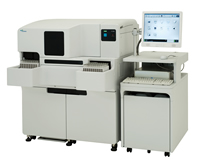News
News
Sysmex Launches LIASAUTO P-FDP Hemostasis Reagent
-Enhanced Reagent Performance Leading to Higher Testing Efficiency and Cost Reductions-
Sysmex Corporation (HQ: Kobe, Japan; Chairman and CEO: Hisashi Ietsugu) is launching new reagent, LIASAUTO P-FDP, for the hemostasis field that can be used in its CS-Series of fully automated coagulation analyzers, as well as the CA-7/8000, CA-1500, CA-6/550 and Coagrex-800.
This FDP1 test reagent allows for a broad scope of testing and lowers the percentage of testing that requires repetition, thereby reducing reporting times and costs. The reagent can also be used in conjunction with a D-dimer1 test to diagnose disseminated intravascular coagulation (DIC)2 and in the selection of appropriate treatment methods. Aimed at providing utility in a clinical setting in these ways, the reagent heightens reactivity to fibrinogen degradation products.
The blood flowing through our bodies typically maintains a fine balance between the mechanism that causes the blood that escapes outside the vessels to clot (coagulation) and the mechanism that prevents the blood flowing inside our vessels from clotting, furthermore the mechanism dissolving blood clots (fibrinolysis) and returning them to their original liquid state. An imbalance between these functions can lead to conditions in which the blood does not clot, as in hemophilia. Alternatively, conditions can emerge as a result of blocked blood vessels, such as cerebral infarction and deep-vein thrombosis. In 2012, thrombus was at the root of the world’s first and second leading causes of death: ischemic heart disease and cerebral embolism3. Early diagnosis and early treatment of these diseases are required, thus testing of blood coagulation and fibrinolysis functions plays an important role.
Sysmex’s new product LIASAUTO P-FDP is used in FDP testing to determine blood hyperfibrinolysis and hypercoagulable status. Important in testing for diagnosing disseminated intravascular coagulation (DIC) and thrombosis, the use of this reagent in conjunction with the D-dimer test is said to allow the type of DIC to be determined.
As the reagent allows high measurement values, the retesting of high-value samples is no longer required. This ability to generate a measurement after only a single test means that measurement can be performed quickly. In order to improve efficacy in determining DIC disease types, we have employed a newly acquired proprietary technology to increase the reagent’s reactivity to fibrinogen degradation products.
Furthermore, using this reagent in combination with an accuracy control substance required for testing, and the D-dimer test reagent, reduces the effort needed to adjust and manage reagents, thereby enhancing usability. Accuracy control is also compatible with external accuracy control services which support quality assurance in testing results.
Through these products and services, Sysmex aims to accelerate its emergence as a comprehensive manufacturer of hemostasis instruments and reagents, contributing to the selection of more appropriate treatment methods and the provision of a high-quality testing environment.
Going forward, Sysmex aims to reduce the burden on patients and enhance the quality of testing, as well as instilling its customers with confidence.
| New Product Overview | |||
|
Name: |
LIASAUTO P-FDP |
||
| Target use: |
Measurement of fibrinogen and fibrin degradation product (FDP) in blood plasma and blood serum |
||
| Launch: | May 2014 | ||
| Target market: | Japan | ||
| Target facilities: | Medium- to large-scale hospitals and commercial labs | ||
| NHI points: | 80 | ||

LIASAUTO P-FDP hemostasis reagents

CS-5100 fully automated coagulation analyzer」
| 1 |
FDP/D-dimer: FDP is an inclusive term referring to the degradation products of fibrinogen and fibrin during hemostasis and clotting. D-dimer is one such FDP, or fibrin degradation product. Testing for FDP and D-dimer allows the clotting mechanism (coagulation) and the clot dissolving mechanism (fibrinolysis) to be checked. |
| 2 |
Disseminated intravascular coagulation (DIC): In the presence of underlying conditions, the hypercoagulable status in the blood persists, prompting the widespread outbreak of tiny clots in peripheral blood vessels, triggering mainly bleeding and organ-related symptoms. With organ-related symptoms, the blood is not transferred to the tissues, with circulatory disorder leading to dysfunction. Early diagnosis and treatment are key, as the prognosis tends to be extremely serious once a clinical condition is reached. Leading underlying conditions include leukemia and malignant tumors, infectious diseases (frequently resulting in septicemia) and aortic aneurisms. DIC disease patterns include the hypercoagulation type, fibrinolysis balanced type and the hyperfibrinolysis type. FDP testing incorporates Ministry of Health, Labour and Welfare’s DIC diagnostic standards; ISTH overt-DIC diagnostic standards; and acute DIC diagnostic standards. |
| 3 | Source: WHO, The top 10 causes of death |
- Information contained in the news release is current as of the date of the announcement,
but may be subject to change without prior notice.
